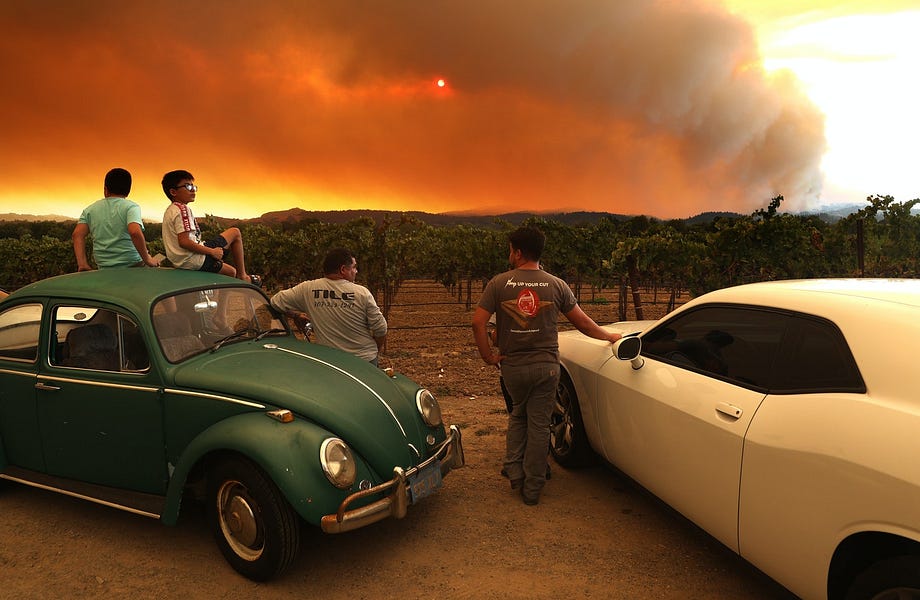In what has become a yearly ritual in Northern California, tens of thousands of residents have evacuated their homes, with millions more experiencing dangerous levels of smoke and ash in the air, as fires continued to rage across the region, sparked by dry thunderstorms.
The state is currently experiencing the second- and third-largest conflagrations in its history, with the SCU Lightning Complex fire covering 363,772 acres and the LNU Lightning Complex fire engulfing 352,913 acres as of Tuesday morning. More than 1,000 structures have been destroyed, and the number of confirmed fatalities currently stands at seven.
Officials were extremely concerned that Sunday and Monday would bring further lightning storms, stretching overworked and thinly spread firefighting crews past their breaking point, but the last few days have thankfully seen a relative cooling-off. Crews have used the break in the weather to make some (meager) progress: The SCU and LNU complexes have been 15 percent and 27 percent contained, respectively. But Cal Fire, the statewide firefighting agency, warns that beating back this wave could take weeks.
Residents across the region are preparing “go bags” for swift evacuation, clearing 30 foot areas around their homes as a “defensible perimeter” for firefighters, and dealing, however they can, with omnipresent smoke and ash. Even in San Francisco’s Financial District, the skyscrapers were bathed in an odd yellow light and the air smelled like woodsmoke on Monday.
California’s “fire season”—June to December, due to the dry weather—rarely gets off to such a roaring, terrifying start: Around 1.4 million acres have already burned thus far in 2020, exceeding the year-end totals of every year but 2018. Four months remain.
The almost unprecedented size of the blazes is due in part to a perfect storm—literally, California was battered by dry thunderstorms last week. These “lightning sieges” occur every 10 to 15 years in the state, sparking hundreds of blazes that link together to form the aforementioned “lightning complexes.”
Jon Keeley, a research scientist at the U.S. Geological Survey, stressed that these weather patterns and associated fires are not new. “On a decadal scale, this is not bizarre,” he tells The Dispatch. “This is not some Armageddon, this is something that has happened before, [and] will happen again.”
While important, Keeley said, warming temperatures are far from the only factor contributing to the state’s fire woes. He noted that 2008 saw similarly large lightning storms and wildfires, even in the absence of a heat wave like 2020’s. “Fire is more complicated than what the climatologists are saying,” he said.
In fact, California’s current situation may stem largely from the state’s own firefighting success. Keeley said the “vast majority” of the Santa Cruz Mountains area currently in flames “has never burned since 1910; this is a result of fire suppression.”
Human efforts to squelch blazes before they spread—successful firefighting—have created large stretches of forest where undergrowth piles up, waiting to act as kindling for a massive firestorm. This is not natural: In a world without human interference, smaller fires would have periodically cleared out the fuel. In many parts of the state, Californians have, in effect, traded multiple smaller fires for fewer, much larger, ones.
The fire season in California, Keeley said, is split into roughly two phases. The first is what the state is experiencing right now, and largely consists of “fuel-dominated” fires like the SCU Lightning Complex. The second phase is made up mostly of “wind-dominated” fires, occurring predominantly in the fall, when the strong, dry, Santa Ana winds sweep into the coastal areas of the state. They depend on ignition events, like arson or downed power lines, to take off.
This second phase is much more dangerous: While the current fires are extremely large, they have, for the most part, occurred in low density areas. Wind-dominated fires, however, can spread to cities and towns much more easily. The 2018 Camp Fire, for example, resulted in 85 fatalities and more than 18,000 structures destroyed.
Wind-dominated fires are becoming more frequent, and power lines have recently overtaken arson as their most common ignition. “Population growth is fundamental” to these trends, Keeley says. More people (and electricity), in more places, means more fire risk. In 1964, the Hanley Fire in Sonoma County destroyed 100 structures and killed no one. In 2017, the Tubbs Fire, covering largely the same area, destroyed 5,500 structures and killed 22.
So California has two different phases to its fire season, and both are getting worse—albeit for different reasons. But Keeley stressed a few tangible reforms that could go a long way in limiting the damage.
The effective use of controlled burns in remote areas where lightning strikes tends to start fires that can keep fuel from accumulating. Improved power line safety and emergency preparedness measures can better protect coastal areas most susceptible to wind-dominated fires.
But the state has to get through this year’s fire season, first. As Cal Fire unit chief Shana Joness aid in a Tuesday press briefing, “Once this fire is done, we have a very long time to go.”
James Sutton is an ISI fall fellow for The Dispatch.







Please note that we at The Dispatch hold ourselves, our work, and our commenters to a higher standard than other places on the internet. We welcome comments that foster genuine debate or discussion—including comments critical of us or our work—but responses that include ad hominem attacks on fellow Dispatch members or are intended to stoke fear and anger may be moderated.
With your membership, you only have the ability to comment on The Morning Dispatch articles. Consider upgrading to join the conversation everywhere.